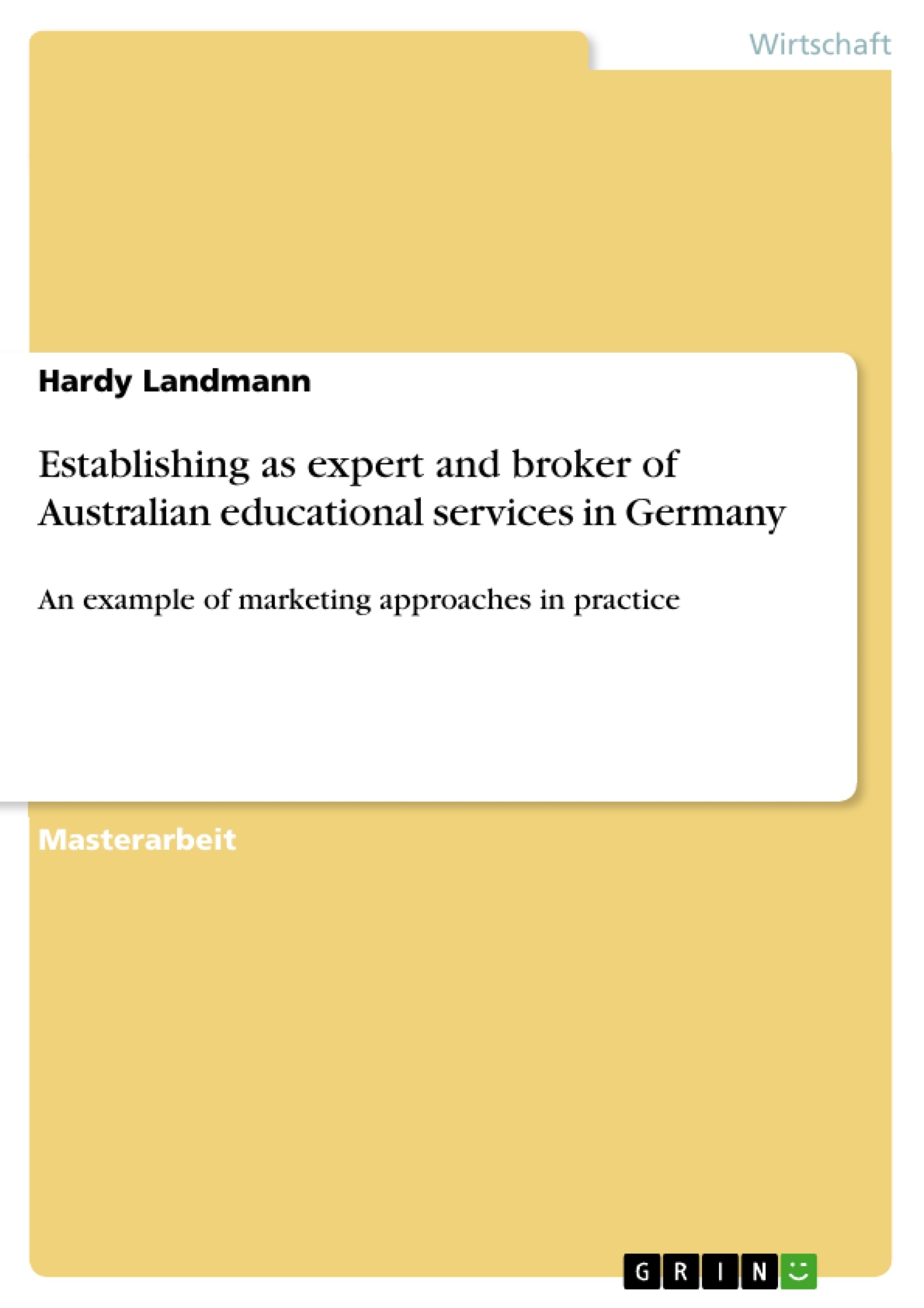Masterthesis zu einem Marketing-Thema in englischer Sprache.
Inhaltlich wird die Vermarktung australischer Bildungsdienstleistungen in Deutschland fokussiert.
Der Forschungsteil beschäftigt sich zunächst ausführlich mit dem australischen Bildungssystem um folgend Kostenvergleiche von Englisch-Sprachkursen in Deutschland, England, Malta und Australien anzustellen. Weiterhin beschreibt der Autor gründlich seine individuelle Auseinandersetzung sowie seinen Wissensstand mit dem Titelthema.
Der Marketingteil startet mit einer intensiven Marketingplanung (Gliederungspunkte u.a. Vision des Autors, Mission objectives, Intention des Autors, Diskussion des Produkts, Bestimmung Zielmarktes & Marktanalyse). Ein weiteres Kapitel setzt Marketinginstrumente in die Praxis um und baut hierbei auf dem McCarthy-Modell der 4P auf (Product, Price, Place, Promotion)
Der Autor involviert durchweg viele Praxisbeispiele, die u.a. auch auf persönliche Umstände des Autors basieren (z.B. Verfolgung eines Opportunitätskostenansatzes auf Basis des eigenen Einkommens).
Insgesamt 119 Seiten, davon 38 Anhang.
Inhaltsverzeichnis
- 1 Einführung
- 1.1 Hintergrund
- 1.2 Zweck der Arbeit
- 1.3 Abgrenzung
- 1.4 Vorgehensweise
- 2 Das Bildungssystem in Australien
- 2.1 Struktur des australischen Bildungssystems
- 2.2 Die Rolle von Sprachschulen
- 2.3 Vergleich der Studiengebühren
- 2.4 Zusätzliche Annehmlichkeiten Australiens
- 2.5 Zwischenergebnisse
- 3 Recherche in Australien
- 3.1 Ausbildung zum „Qualified Education Agent“
- 3.2 Verträge mit Sprachkollegs
- 3.3 Exkursion: Marketingkampagne für das International House Brisbane
- 3.4 Veröffentlichung eines E-Books
- 3.5 Teilnahme an einem Seminar für Bildungsvermittler
- 3.6 Zwischenergebnisse
- 4 Marketingvorbereitung
- 4.1 Planung des Marketings
- 4.2 Grundfragen des Marketings
- 4.3 Bestimmung und Messung des Marktes
- 4.3.1 Analyse 1: Deutsche, die Australien längerfristig besuchen
- 4.3.1.1 Studentenvisuminhaber
- 4.3.1.2 Working-Holiday-Visuminhaber
- 4.3.2 Analyse 2: Deutsche, die durch Sprachreisen Englisch lernen
- 4.3.3 Analyse 3: Deutsche, die eine Ausbildung in Australien absolvieren
- 4.3.4 Analyse 4: Deutsche, die Englischkurse in Australien absolvieren
- 4.4 Marktsegmentierung
- 4.4.1 Segmentierung Nr. 1: Deutsche Studentenvisum-Anmeldungen in 2009
- 4.4.2 Segmentierung Nr. 2: Working-Holiday-Visuminhaber
- 4.4.3 Segmentierung Nr. 3: Deutsche Sprachreisende
- 4.4.4 Analyse und Abbildung der Marktsegmente
- 4.4.5 Auswahl eines Marktsegments
- 4.4.6 Kundenprofil
- 4.4.7 Auswirkungen auf den Produktmix
- 4.5 Externe Einflüsse auf das Marketing
- 4.5.1 Wettbewerbsanalyse
- 4.5.2 PEST-Analyse
- 4.5.3 Marktbeobachtung
- 4.6 Zwischenergebnisse
- 5 Entwicklung eines Marketing-Mix
- 5.1 Produkt
- 5.1.1 Analyse der Produkte
- 5.1.2 Individuelle Probleme der Produkte
- 5.1.3 Marketing und Werbung immaterieller Produkte
- 5.1.3.1 Fotografien
- 5.1.3.2 Marken
- 5.1.3.3 Markenwerbung: Ein Slogan
- 5.2 Preis
- 5.2.1 Kostenorientierte Vorgehensweise
- 5.2.2 Konkurrenzorientierte Vorgehensweise
- 5.2.3 Bundle Pricing
- 5.2.4 Angewandte Preispolitik
- 5.3 Platz
- 5.3.1 Logistik der Produkte
- 5.3.2 Der Vertrieb der Produkte
- 5.3.3 Selektive Vertriebspolitik
- 5.4 Promotion
- 5.4.1 Persönlicher Verkauf
- 5.4.2 Empfehlungsmarketing
- 5.4.3 Direktmarketing
- 5.4.3.1 E-Mail-Signatur
- 5.4.3.2 Business-Netzwerk: Xing
- 5.4.4 Öffentlichkeitsarbeit
- 5.4.4.1 Poster
- 5.4.4.2 E-Book
- 5.5 Zwischenergebnisse
Zielsetzung und Themenschwerpunkte
Diese Masterarbeit untersucht die Etablierung eines Experten und Vermittlers für australische Bildungsdienstleistungen in Deutschland. Die Arbeit analysiert Marketingansätze in der Praxis und zielt darauf ab, eine erfolgreiche Marketingstrategie zu entwickeln und zu evaluieren.
- Etablierung eines australischen Bildungsdienstleisters in Deutschland
- Analyse und Anwendung verschiedener Marketingstrategien
- Marktforschung und -segmentierung im Kontext des deutschen Bildungstourismus
- Entwicklung eines Marketing-Mix für immaterielle Produkte
- Bewertung der Ergebnisse und Ausblick auf zukünftige Marketingansätze
Zusammenfassung der Kapitel
Kapitel 1 führt in die Thematik ein und beschreibt die Zielsetzung und Vorgehensweise der Arbeit. Kapitel 2 bietet einen Überblick über das australische Bildungssystem, inklusive Sprachschulen und Kostenvergleiche. Kapitel 3 dokumentiert die Recherchen des Autors in Australien, inklusive Ausbildung, Vertragsabschlüssen und Marketingaktivitäten. Kapitel 4 befasst sich mit der Marketingvorbereitung, inklusive Marktforschung, Segmentierung und Wettbewerbsanalyse. Kapitel 5 beschreibt die Entwicklung eines Marketing-Mix, mit Fokus auf Produkt, Preis, Platz und Promotion.
Schlüsselwörter
Australisches Bildungssystem, Marketing, Marktforschung, Marktsegmentierung, Bildungstourismus, Deutschland, Sprachschulen, Produktmarketing, Preispolitik, Vertriebspolitik, Promotion, Qualified Education Agent.
- Quote paper
- M.A. Hardy Landmann (Author), 2011, Establishing as expert and broker of Australian educational services in Germany, Munich, GRIN Verlag, https://www.grin.com/document/183040



